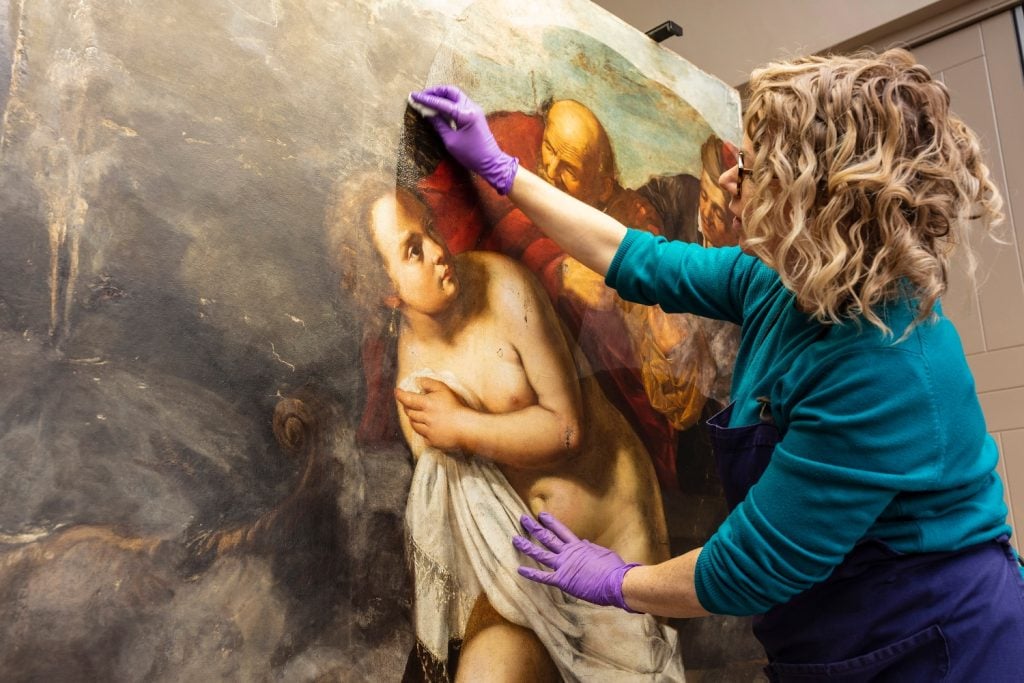Art History
The U.K.’s Royal Collection Has Discovered a Long-Lost Artemisia Gentileschi Painting That Was Left to Collect Dust in Storage for a Century
The painting had once hung over the Queen's private fireplace.

The painting had once hung over the Queen's private fireplace.

Jo Lawson-Tancred

An incredibly rare, long-lost painting by Artemisia Gentileschi has been rediscovered in the U.K.’s Royal Collection. The Italian Baroque painter produced Susanne and the Elders while working with her father Orazio at the court of King Charles I in London in the 1630s.
“Artemisia was a strong, dynamic and exceptionally talented artist whose female subjects—including Susanna—look at you from their canvases with the same determination to make their voices heard that Artemisia showed in the male-dominated art world of the 17th century,” said deputy surveyor of the King’s pictures, Anna Reynolds, in a press statement.
Until now, the painting had been misattributed to the “French School.” It was left to collect dust in storage at Hampton Court Palace for over 100 years, falling into a very bad condition. The masterpiece was rescued thanks to the expertise of art historian Niko Munz and a team of the Royal Collection’s curators, who were researching the whereabouts of paintings that were presumed to have been lost or sold from royal collection after Charles I was executed in 1649.

Artemisia Gentileschi, Susanna and the Elders (ca. 1638–39) following the completion of extensive conservation treatment. Photo courtesy of the Royal Collection Trust/©His Majesty King Charles III 2023.
An avid art collector and patron, Charles I had owned seven paintings by Artemisia but it was long believed that only one, Self-Portrait as the Allegory of Painting (ca. 1638–39), survived. Upon closer inspection of works in storage, the curators managed to match the description of Susanna and the Elders to the neglected canvas now attributed to Artemisia.
Allowing their hopes to be raised, the experts arranged for the painting to be cleaned and conserved. Their suspicions were confirmed when a “CR,” referring to “Carolus Rex,” was found on the back of the canvas, indicating that the work had once belonged to Charles I. Its history has now been traced thanks to official records that show it was commissioned by the king’s wife Henrietta Maria in around 1638–39.
“One of the most exciting parts of this painting’s story is that it appears to have been commissioned by Queen Henrietta Maria while her apartments were being redecorated for a royal birth,” said Munz. The work hung over the fireplace in her withdrawing chamber, a private room for relaxing and receiving a small number of guests.
The painting was returned to the king’s son Charles II after the restoration in 1660, where it hung in Somerset House. A watercolor from 1819 shows it leaning against a wall in the Queen’s Bedchamber at Kensington Palace. At this time, Artemisia’s reputation had waned and the work was eventually moved to Hampton Court Palace. The last record shows that it underwent a restoration in 1862, which at that time entailed heavy overpainting, before falling into obscurity.
One of very few renowned woman artists working in the 17th century, Artemisia trained under her father in Rome and worked throughout Italy and in London. She has become particularly celebrated in recent years, with the National Gallery in London acquiring Self-Portrait as Saint Catherine of Alexandria (c. 1615–17) in 2018. Another rediscovered work by Artemisia was sold by Sotheby’s earlier this year.
The newly restored Susanna and the Elders has gone on public display alongside her Self-Portrait and a painting by her father, Joseph and Potiphar’s Wife, at Windsor Castle, just outside London.
More Trending Stories: